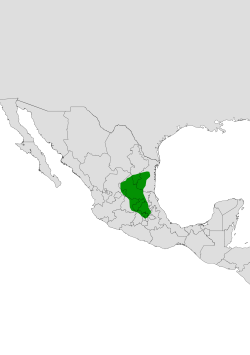Biology:Echinocereus cinerascens
| Echinocereus cinerascens | |
|---|---|

| |
| Scientific classification | |
| Kingdom: | Plantae |
| Clade: | Tracheophytes |
| Clade: | Angiosperms |
| Clade: | Eudicots |
| Order: | Caryophyllales |
| Family: | Cactaceae |
| Subfamily: | Cactoideae |
| Genus: | Echinocereus |
| Species: | E. cinerascens
|
| Binomial name | |
| Echinocereus cinerascens (DC.) Lem.
| |

| |
| Synonyms | |
|
Cereus cinerascens DC. 1828 | |
Echinocereus cinerascens is a species of cactus native from Texas to Mexico.
Description
Echinocereus cinerascens grows with many shoots and usually forms cushions of prostrate to upright shoots. The bright green, cylindrical shoots are up to 30 centimeters long and have a diameter of 1.5 to 12 centimeters. There are five to twelve ribs, which usually have well-developed cusps, but are occasionally almost uncusped. The one to six protruding to spreading, sometimes criss-crossing central spines are slightly pink or orange and turn brown or even white. They are up to 4.5 centimeters long. The six to ten round, yellowish to whitish marginal spines are 1 to 3.5 centimeters long.
The broadly funnel-shaped flowers are slightly pink-magenta in color and have a white or very light throat. They appear well below the shoot tips, are 7 to 10 centimeters long and reach a diameter of 6 to 12 centimeters. The green and thorny fruits smell and taste like strawberries.[2]
Subspecies
Accepted subspecies:[3]
Distribution
Echinocereus cinerascens is distributed in Mexico in the Federal District and the states of México, Hidalgo, Tamaulipas, Querétaro, Guanajuato, Zacatecas and San Luis Potosí.
Taxonomy
The first description as Cereus cinerascens by Augustin-Pyrame de Candolle was published in 1828.[4] The specific epithet cinerascens comes from Latin, means 'turning ashen' and refers to the thorns of the species. Charles Lemaire placed the species in the genus Echinocereus in 1868.[5]
References
- ↑ SG), Succulent Plants; SG), Succulent Plants; Biología, Héctor Hernández (Instituto de; Assessment), Martin Smith (Global Cactus (2009-11-16). "The IUCN Red List of Threatened Species". IUCN Red List of Threatened Species. https://www.iucnredlist.org/species/152182/121461911. Retrieved 2023-12-10.
- ↑ Anderson, Edward F.; Eggli, Urs (2005) (in de). Das grosse Kakteen-Lexikon. Stuttgart (Hohenheim): Ulmer. pp. 193–194. ISBN 3-8001-4573-1.
- ↑ "Echinocereus cinerascens (DC.) Haage". 2019-02-27. https://powo.science.kew.org/taxon/urn:lsid:ipni.org:names:132332-1.
- ↑ D&Amp, Um National; (France), histoire naturelle (1828). "Mémoires du Muséum d'histoire naturelle". G. Dufour. https://www.biodiversitylibrary.org/page/26229183.
- ↑ Lemaire, C. (1869) (in fr). Les cactées: histoire, patrie, organes de végétation. Bibliothèque du jardinier. Maison rustique. p. 56. https://books.google.com/books?id=Qu_WZxpub0oC&pg=PA56. Retrieved 2023-12-10.
External links
Wikidata ☰ Q1280368 entry
 |





